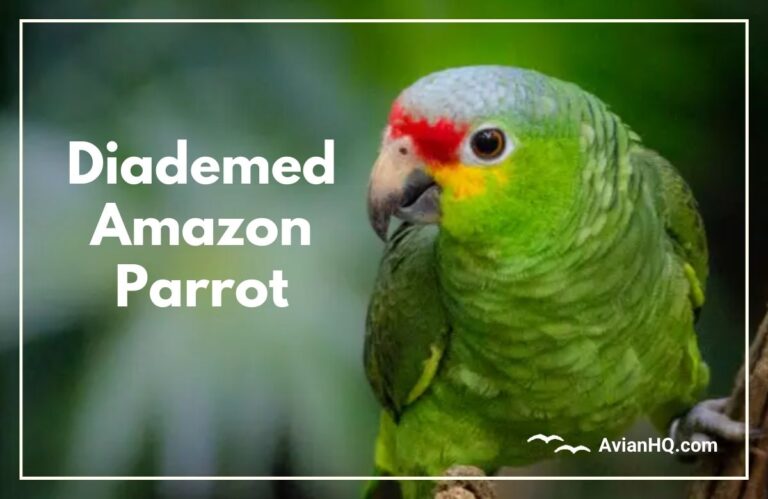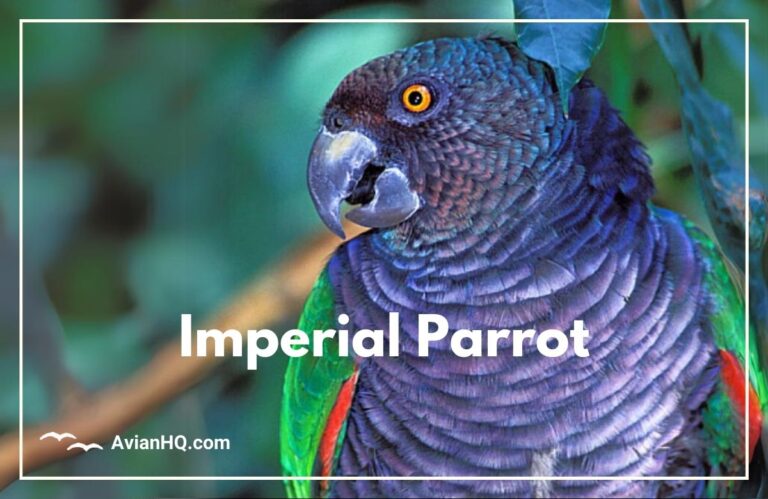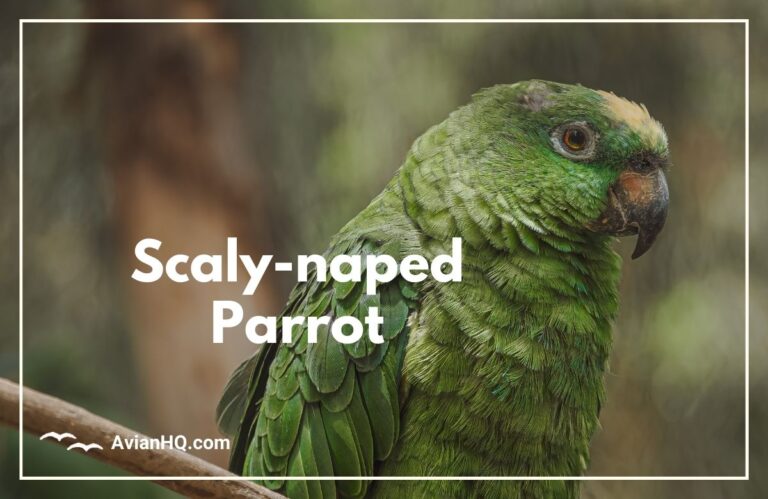Lilac-crowned Amazon Parrot (Amazona finschi)
The Lilac-crowned Amazon Parrot, also known by it’s scientific name Amazona finschi, is a gorgeous medium-sized parrot native to the Pacific coastal forests of Mexico. If you’re not yet familiar with this stunning species, get ready to meet your new favorite parrot!
With it’s bright green feathers, maroon-tinged forehead, and distinct lilac crown and neck plumage, the Lilac-crowned Parrot really lives up to it’s common name. The [burst of color] on it’s head makes it stand out from other parrot species. These parrots reach about 13 inches (33 cm) in length and weigh between 12-18 ounces (350-500 grams).
Lilac-crowned Parrots can be found flying through the canopy in small flocks or foraging on fig trees in Mexico’s tropical [deciduous forests]. Sadly though, habitat destruction and capture for the pet trade have caused this species to decline significantly. The Lilac-crowned Parrot is now classified as Endangered by the IUCN Red List.
In this article, you’ll learn all about the natural history, physical appearance, habitat, ecology, and conservation efforts surrounding this exceptional parrot.
History and Taxonomy
The Lilac-crowned Amazon was first described scientifically in 1864 by Philip Lutley Sclater, an English lawyer and zoologist. He named the species Amazona finschi in honor of Otto Finsch, a German ethnographer and naturalist who extensively studied the birds of the Pacific region.
So while Sclater performs the official species description and naming, much of the early research and observation of the Lilac-crowned Parrot in the wild was done by Finsch himself. This recognition must have been greatly appreciated by Finsch!
The species is classified in the genus Amazona, which includes roughly 30 species of vibrant, medium-sized parrots in Central and South America. More specifically, the Lilac-crowned Parrot belongs to the albifrons species group, which are characterized by their bright red foreheads. Other examples include the Red-lored Amazon (A. autumnalis) and the Red-crowned Parrot (A. viridigenalis).
While some Amazona species have distinct subspecies, there are no formally recognized subspecies of the Lilac-crowned Parrot. There are just minor regional variations in size and plumage color. So A. finschi refers exclusively to this single magnificent species endemic to Mexico’s Pacific coast.
Physical Appearance
The Lilac-crowned Parrot is a stocky green parrot reaching about 13 inches (33 cm) in length. Their average weight ranges from 12-18 ounces (350-500 grams).
As their name implies, these parrots have bright plumage colors. Their predominant body color is green, with more yellowish-green underparts and undertail coverts. The feathers along the neck and breast are boldly edged in black, giving a neat scalloped look.
The most eye-catching feature is the vibrant maroon-red forehead and forecrown, contrasting sharply with the lilac-blue crown extending across the back of the neck. Their cheeks are a bright greenish-yellow color.
In flight, you may catch a glimpse of Lilac-crowned Parrots’ brilliant blue wing patches and prominent red speculums along the secondary feathers. Their long tail feathers are green with yellowish-green tips.
Their bill is a pale horn color. Adults have orange irises, while juveniles start out with brown eyes that change to orange over their first year. Their feet and legs are a greenish-gray color.
So with an array of red, blue, green, yellow, black, and lilac plumage, the Lilac-crowned Parrot shows off quite the spectrum! Their unique color combination makes them easy to distinguish from other similar parrot species.
Habitat and Distribution
The Lilac-crowned Parrot is endemic to the Pacific coastal region of Mexico. It’s range stretches along the Pacific slope from Sonora state down to Oaxaca.
These parrots inhabit humid tropical and subtropical forests, including semi-deciduous, deciduous, and oak-pine woodlands. They seem to prefer drier forest habitats over wet rainforests. Lilac-crowned Parrots occur at elevations ranging from sea level up to about 6,500 feet (2,000 m).
In parts of their historic range like Oaxaca and Colima, the Lilac-crowned Parrot has sadly been extirpated or completely wiped out due to pressures from habitat loss and trapping. Their remaining strongholds are the western Mexican states of Sinaloa, Nayarit, and Jalisco.
Over the past few decades, small introduced populations of Lilac-crowned Parrots have become established in urban and suburban areas of Southern California in the United States. For example, groups are found year-round in Los Angeles and Orange County. It’s presumed these non-native populations arose from escaped or intentionally released pet birds.
So if you’re in Mexico west of the Sierra Madre mountains in the appropriate habitat, listen for the loud squawks of Lilac-crowned Parrot flocks passing overhead through the forest canopy.
Diet and Feeding
In the wild, Lilac-crowned Parrots are opportunistic feeders. They utilize a wide variety of food sources depending on local availability within their forest habitats.
Flocks exhibit seasonal movements to track the ripening of certain preferred fruits. One of their favorites are figs from forest strangler figs. They also readily feed on other fruits like palms, podocarpus, and jacaranda.
The Lilac-crowned Parrot diet is supplemented with seeds, nuts, berries, buds, edible flowers, and new leaf growth. At times, they may cause localized crop damage, feeding on cultivated bananas, corn, and other grains. Their strong bills allow them to crack hard nuts and seeds.
These social parrots are most easily observed when aggregating in groups to feed. For example, they regularly form large, noisy foraging flocks of hundreds of individuals clamoring to get their share from fruiting trees.
In captivity as pets, the basic diet of Lilac-crowned Parrots should include a quality seed mix or pelleted base along with chop mixes with fruits, veggies, grains, and nuts to provide variation. A nutritious diet supports proper growth and feathering. Consult an avian veterinarian for tailored diet advice.
Breeding and Reproduction
In the wild, the breeding season for Lilac-crowned Parrots runs from February to June. As cavity nesters, they nest in the hollows of tall rainforest trees, palms, or even fence posts.
Pairs likely mate for life. They defend nest sites from other competing parrot pairs in the area. Careful observation may reveal courtship feeding by the male.
The average clutch size is 3-4 white eggs. The female incubates the eggs for 26-28 days until hatching. Meanwhile, the male passes food to her in the nest hollow.
Both parents feed the altricial chicks through the nestling period. Chicks fledge at around 8-10 weeks of age, when they take their first flights from the nest. However, the parents continue to supplement feed and teach them foraging skills as juveniles.
In captivity, successful captive breeding requires correctly sexed, compatible pairs provided with next boxes. Lilac-crowned Parrots are less commonly bred than other parrot species. Experienced aviculturalists recommend leaving breeding to qualified experts to maintain genetic diversity.
Behavior and Ecology
Lilac-crowned Parrots exhibit a high degree of sociality. Outside the breeding season, they form large communal roosts containing between 100 to over 1,000 individuals!
At daybreak, these roosts break up as the bright green flocks set out to forage. Throughout the day, they utilize their strong beaks to access hard nuts and seeds other birds can’t exploit. In the late afternoon, vocalizations escalate as the groups reconvene at traditional roosting sites.
Their loud squawks and screams contribute to complex systems of flock communication. Pairs likely maintain long-term monogamous bonds. Dominant pairs may defend prime nesting and roosting resources in a given area.
In forests shared with other parrot species like macaws, Lilac-crowned Parrots appear subordinate. They may adjust their foraging schedules around the larger species. However, their greater numbers gives them safety in numbers when aggregating in huge flocks.
Lilac-crowned Parrots bathe regularly in streams and water pooled in tree hollows. Their bright plumage results from the constant preening and distribution of oils from the preen gland.
Conservation Status
Due to ongoing population declines, the Lilac-crowned Parrot is listed as Endangered on the IUCN Red List of Threatened Species. It is also included in Appendix I of CITES, banning international commercial trade.
The major threats this species faces are habitat destruction, capture for the pet trade, and persecution as an agricultural pest. Logging, land conversion for agriculture, development, and forest fires continue eroding their specialized forest habitat.
Across their original Mexican range, overall populations have decreased by 20-49% since records began. In particular regions like Oaxaca and Colima, they have been completely extirpated. Current total wild population size is uncertain but estimated between 7,000-10,000 mature individuals and decreasing.
In Mexico, protected areas like the Chamela-Cuitzmala and Sierra de Manantlan Biosphere Reserves harbor important populations. Further habitat protection, captive breeding networks, and crackdowns on illegal capture offer conservation hopes for the future.
For us as bird lovers and parrot enthusiasts, we can raise awareness about endangered species like the Lilac-crowned Parrot. Support organizations coordinating avian conservation action in Mexico and Central America.
Conclusion
The vibrant Lilac-crowned Parrot perfectly embodies the beauty and imperilment of Mexico’s threatened forest habitats. As development and deforestation marches on, these charismatic parrots have lost over a third of their former range. Their future survival hangs in the balance.
Yet hope remains for Amazona finschi. Thanks to the efforts of avian conservation groups across Central America, protected areas safeguard key breeding populations. And the interests of ecotourists, birders, and parrot enthusiasts alike bring external incentive to preserve essential parrot habitats.
Beyond just being a striking “pretty polly” locking eyes with us from it’s perch, the Lilac-crowned Parrot serves as an umbrella species. Efforts aimed at it’s forest ecosystem preservation indirectly aid many other plant and animal species sharing the same habitat. The Lilac-crowned Parrot reminds us our world relies on interdependence and diversity. Our actions matter, even from afar.
So next chance you get, look around for organizations protecting habitat corridors across Mexico near you to support. Or consider symbolic “adoption” of an endangered parrot. Keep up hope for the Lilac-crowned Parrot’s future, for all our sakes.







